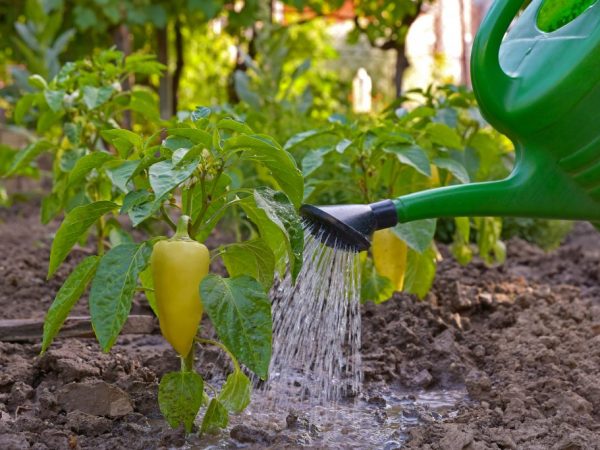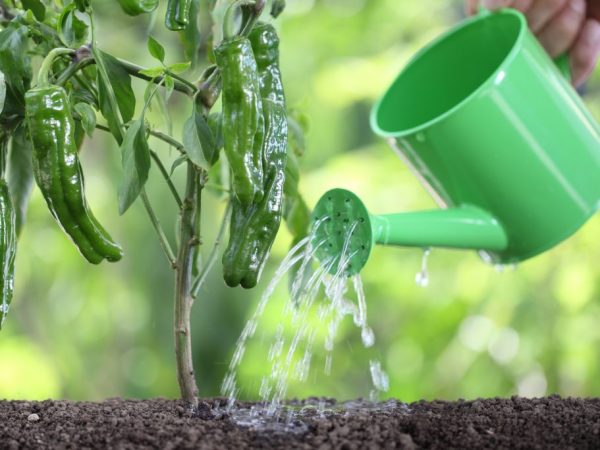Watering the peppers with iodine
Strengthening growth, enriching the soil with nitrogen, preventing disease - all this can ensure timely fertilization and watering with top dressing. Peppers are one of the most fertilizing plants, but not everyone likes to use chemicals in the garden. One way to avoid chemicals is to water the peppers with iodine.

Watering the peppers with iodine
When iodine supplementation is required
Iodine is an essential element for the growth of most plants. Usually it is present in the soil in small quantities, therefore, its timely addition to fertilizers will have a positive effect on the formation of the bush and fruits. Top dressing for peppers with iodine is carried out, because this substance:
- Enhances the ability of plants to absorb nitrogen. Nitrogen, in turn, enhances plant growth and increases yields.
- Affects the saturation of fruits with vitamin C. With sufficient feeding, peppers contain up to 10 times more vitamin than before.
- Affects the taste, color and size of peppers.
- Increases plant immunity, resists fungal diseases.
Application
Iodine is a folk remedy. It can be purchased at any pharmacy. The substance can be used at different stages of plant growth.
Seed treatment
Seeds can also be treated with iodine for disinfection, prevention of diseases and acceleration of hatching. The solution is prepared in a container with water: 1 drop per 1 liter of water. The seeds are placed in a container with a solution for 6 hours. After processing, they are immediately planted in containers with soil.
Watering seedlings
Seedlings of peppers and tomatoes are watered with top dressing when the seed has hatched and 2-3 true leaves have appeared on the surface. Usually, plants are watered only for feeding, but the solution can also be used for the prevention and treatment of fungal diseases.
- The recipe for an iodine solution for feeding peppers seedlings: 1 drop per 3 liters of water. This is enough for planting seedlings in the ground and forming healthy plants.
- For the treatment of fungal diseases, as well as their prevention, a more concentrated solution is used. Take 2-3 drops per 3 liters of water. Seedlings are watered a week before planting in the ground.
- You can use a mixture with mineral fertilizers. 10 g of iodine, 20 g of potassium, 10 g of phosphorus are mixed in a bucket of water. This mixture is used every 2 weeks.
After applying top dressing, the seedlings must be watered with clean water. In order for the plant to have enough of this substance, it is enough to add a small amount of it to the seedlings. This is why only one of the above methods is used. From an overdose of this substance, the bush can get sick and die.
Watering an adult plant

Watering with iodine increases plant productivity
This folk remedy helps to increase the number of fruits on the bush and their size by about 15%. Feeding peppers with iodine also affects the growth of the green part of the bush. So that the green part does not take all the nutrients from the fertilizers into itself, the period of top dressing is calculated. Adding it ahead of time will give rise to the green part. In this case, the plant will no longer have the strength to form the fruit.For peppers and tomatoes, watering the solution under the root and watering the entire plant is used:
- Top dressing is carried out during the period of tying the brushes. The solution contains 3 drops per 10 liters of water. 1 liter of solution is poured under one bush.
- Foliar dressing is used to protect against diseases. The solution contains 2 drops per 1 liter of water. Plants are treated 3 times every 10 days. In the greenhouse, foliar feeding is carried out 2 times every 15 days.
Foliar dressing can be combined with other fertilizers and plant protection products. After the formation of fruits, feeding should be stopped: the plants have already received enough nutrients for the formation of the fruit.
Iodine in the fight against disease
It is possible to process seedlings and adult bushes of tomatoes from late blight and powdery mildew with a solution of water (1 bucket), 1 liter of milk whey, 40 drops of 5% iodine tincture and 1 tbsp. l. hydrogen peroxide. All ingredients are mixed in one container. There should be no sediment. The whole bush is sprayed with the mixture. Watering at the root against late blight is used after the formation of ovaries. The tincture is prepared according to the following recipe:
- prepare 2 liters of wood ash;
- grind and sift ash;
- boil 8 liters of water;
- add sifted ash to boiling or hot water;
- stir and leave to cool;
- add 1 standard bottle of iodine;
- add 10 g of boric acid.
The solution should be infused for 12 hours. The tincture cannot be used in its pure form. It is additionally diluted in water at the rate of 1 liter of tincture per 1 bucket of water. When treating phytophthora, the bushes must be pre-cleaned of diseased leaves and fruits. The solutions are applied only to clean plants.
Bushes are processed 3-4 times per season.
Precautions
An overdose of this substance can be dangerous, therefore it is recommended to adhere to the following safety rules:
- the introduction of this substance is adjusted, depending on the soil and its presence in other fertilizers;
- exact adherence to the dosage guarantees the good quality of the plant and fruits;
- overdose can lead to a curvature of the shape of the fetus;
- foliar feeding should be carried out only in the evening or in the morning;
- foliar dressing in direct sunlight can burn leaves and fruits;
- root feeding should be carried out only after watering the plant;
- when spraying, be sure to wear protective equipment.
Strict adherence to the rules for using iodine for feeding and preventing diseases of seedlings and adult bushes guarantees a good harvest. Plants saturated with iodine transfer the required amount of iodine to the fruit.
When iodine feeding is not needed
The plant does not need iodine treatment if:
- It is part of other fertilizers. When purchasing such fertilizers, carefully look at their composition.
- Usually this substance is found in ash, manure.
- The soil already contains it. Such soils include black soil or the soil where chestnuts used to grow.
- The seaside soil also contains the required amount.
Soils such as saline and gray soil need to be added to irrigation of this substance.


